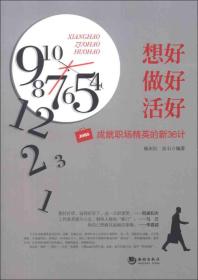
新东方 AP化学5分制胜
批量上传,套装书可能不全,下单前咨询在线客服!图书都是8-9成新,少量笔记,不影响阅读使用!光盘、学习卡、附件等默认不带,有特殊要求,下单前请咨询客服!
¥ 15.6 2.3折 ¥ 68 九品
仅1件
广东佛山
认证卖家担保交易快速发货售后保障
作者[美]John T. Moore (美)Richard H. Langley
出版社西安交通大学出版社
出版时间2018-01
版次1
装帧其他
货号9787560584935
上书时间2024-10-19
- 在售商品 暂无
- 平均发货时间 6小时
- 好评率 暂无
- 最新上架
商品详情
- 品相描述:九品
图书标准信息
- 作者 [美]John T. Moore (美)Richard H. Langley
- 出版社 西安交通大学出版社
- 出版时间 2018-01
- 版次 1
- ISBN 9787560584935
- 定价 68.00元
- 装帧 其他
- 开本 16开
- 纸张 胶版纸
- 页数 392页
- 字数 453千字
- 【内容简介】
-
本系列AP考试丛书引进自美国知名教育出版公司McGraw-Hill Education,由AP考试相关领域专家编写,是美国本土大学课堂使用教材,可以帮助考生提前适应全英学习模式。
《AP化学5分制胜》紧扣考试命题特点,以“五步”方案为学习框架,囊括与考试相关的学科要点。同时,还精选针对性练习以及全真模拟试题,配以准确答案和详尽解析,利于考生巩固所学。此外,考生还可在App Store中搜索“AP Planner”免费下载App,量身定制个性化学习日程。 - 【作者简介】
-
John
T. Moore:资深AP教学与考试专家,拥有多年AP化学教学经验,熟知AP考试特点。
Richard H. Langley:资深AP教学与考试专家,拥有多年AP化学教学经验,曾出版多本AP化学教材,熟知AP考试特点。 - 【目录】
-
STEP
1 Set Up Your Study Program
1 What You Need to Know About the AP Chemistry
Exam, 3
Background of the Advanced Placement
Program, 3
Who Writes the AP Chemistry Exam? 4
The AP Grades and Who Receives Them, 4
Reasons for Taking the AP Chemistry
Exam, 4
Questions Frequently Asked About the AP
Chemistry Exam, 5
2 How to Plan Your Time, 9
Three Approaches to Preparing for the AP
Chemistry Exam, 9
Calendar for Each Plan, 11
STEP
2 Determine Your Test Readiness
3 Take a Diagnostic Exam, 17
Getting Started: The Diagnostic Exam, 18
Answers and Explanations, 28
Scoring and Interpretation, 32
STEP
3 Develop Strategies for Success
4 How to Approach Each Question Type, 35
Multiple-Choice Questions, 35
Free-Response Questions, 38
STEP
4 Review the Knowledge You Need to Score
High,
5 Basics, 45
Units and Measurements, 46
Dimensional Analysis—The Factor Label
Method, 47
The States of Matter, 48
The Structure of the Atom, 48
Periodic Table, 52
Oxidation Numbers, 55
Nomenclature Overview, 55
Experimental, 61
Common Mistakes to Avoid, 61
Review Questions, 62
Rapid Review, 67
6 Reactions and Periodicity, 69
AP Exam Format, 70
General Aspects of Chemical Reactions
and Equations, 70
General Properties of Aqueous Solutions,
71
Precipitation Reactions, 72
Oxidation–Reduction Reactions, 73
Coordination Compounds, 77
Acid–Base Reactions, 78
Experimental, 82
Common Mistakes to Avoid, 82
Review Questions, 83
Rapid Review, 86
7 Stoichiometry, 88
Moles and Molar Mass, 89
Percent Composition and Empirical
Formulas, 89
Reaction Stoichiometry, 91
Limiting Reactants, 92
Percent Yield, 93
Molarity and Solution Calculations, 94
Experimental, 95
Common Mistakes to Avoid, 95
Review Questions, 95
Rapid Review, 101
8 Gases, 102
Kinetic Molecular Theory, 103
Gas Law Relationships, 104
Experimental, 112
Common Mistakes to Avoid, 113
Review Questions, 114
Rapid Review, 118
9 Thermodynamics, 120
Calorimetry, 121
Laws of Thermodynamics, 123
Products Minus Reactants, 123
Thermodynamics and Equilibrium, 127
Experimental, 128
Common Mistakes to Avoid, 128
Review Questions, 129
Rapid Review, 133
10
Spectroscopy, Light, and Electrons, 134
The Nature of Light, 134
Wave Properties of Matter, 136
Atomic Spectra, 136
Atomic Orbitals, 137
Photoelectron (Photoemission)
Spectroscopy (PES), 138
Experimental, 139
Common Mistakes to Avoid, 139
Review Questions, 139
Rapid Review, 142
11
Bonding, 144
Lewis Electron-Dot Structures, 145
Ionic and Covalent Bonding, 145
Molecular Geometry—VSEPR, 149
Valence Bond Theory, 151
Molecular Orbital Theory, 153
Resonance, 154
Bond Length, Strength, and Magnetic
Properties, 155
Experimental, 155
Common Mistakes to Avoid, 155
Review Questions, 156
Rapid Review, 159
12
Solids, Liquids, and Intermolecular Forces, 162
Structures and Intermolecular Forces, 163
The Liquid State, 164
The Solid State, 165
Phase Diagrams, 167
Relationship of Intermolecular Forces to
Phase Changes, 169
Experimental, 169
Common Mistakes to Avoid, 169
Review Questions, 169
Rapid Review, 172
13
Solutions and Colligative Properties, 173
Concentration Units, 174
Electrolytes and Nonelectrolytes, 177
Colligative Properties, 177
Colloids, 181
Experimental, 182
Common Mistakes to Avoid, 182
Review Questions, 182
Rapid Review, 186
14
Kinetics, 188
Rates of Reaction, 189
Integrated Rate Laws, 192
Activation Energy, 193
Reaction Mechanisms, 194
Catalysts, 195
Experimental, 195
Common Mistakes to Avoid, 196
Review Questions, 197
Rapid Review, 201
15
Equilibrium, 203
Equilibrium Expressions, 205
Le Chatelier’s Principle, 206
Acid–Base Equilibrium, 207
Buffers, 215
Titration Equilibria, 216
Solubility Equilibria, 220
Other Equilibria, 222
Experimental, 222
Common Mistakes to Avoid, 223
Review Questions, 223
Rapid Review, 229
16
Electrochemistry, 231
Redox Reactions, 232
Electrochemical Cells, 232
Quantitative Aspects of Electrochemistry,
237
Nernst Equation, 239
Experimental, 240
Common Mistakes to Avoid, 240
Review Questions, 241
Rapid Review, 245
17
Nuclear Chemistry, 247
Nuclear Reactions, 247
Nuclear Stability, 249
Nuclear Decay Calculations, 250
Mass–Energy Relationships, 251
Common Mistakes to Avoid, 252
Review Questions, 252
Rapid Review, 254
18
Organic Chemistry, 255
Alkanes, 256
Structural Isomerism, 258
Common Functional Groups, 259
Macromolecules, 261
Experimental, 261
Common Mistakes to Avoid, 261
Review Questions, 262
Rapid Review, 265
19
Experimental Investigation, 266
Experiment 1: Spectroscopy, 267
Experiment 2: Spectrophotometry, 270
Experiment 3: Gravimetric Analysis, 271
Experiment 4: Titration, 272
Experiment 5: Chromatography, 273
Experiment 6: Determination of the Type
of Bonding in Solid Samples, 274
Experiment 7: Stoichiometry, 275
Experiment 8: Redox Titration, 276
Experiment 9: Chemical and Physical
Changes, 277
Experiment 10: Kinetics, 278
Experiment 11: Rate Laws, 279
Experiment 12: Calorimetry, 280
Experiment 13: Chemical Equilibrium—Le
Chatelier’s Principle, 280
Experiment 14: Acid-Base Titrations, 281
Experiment 15: Buffer pH, 282
Experiment 16: The Capacity of a Buffer,
282
Common Mistakes to Avoid, 283
Review Questions, 283
Rapid Review, 285
STEP
5 Build Your Test-Taking Confidence
AP
Chemistry Practice Exam 1, 289
AP
Chemistry Practice Exam 2, 317
Appendixes
SI Units, 347
Balancing Redox Equations Using the
Ion-Electron Method, 349
Common Ions, 353
Bibliography, 356
Web Sites, 357
Glossary, 358
Avoiding “Stupid Mistakes” on the
Free-Response Section, 367
Exam Resources, 369
点击展开
点击收起
— 没有更多了 —












以下为对购买帮助不大的评价